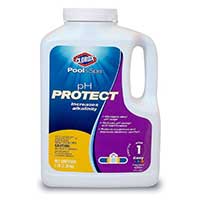Total Alkalinity is the measurement of a pool or spa's susceptibility to pH change. Alkalinity that is out of range allows for large rapid pH swings. Extreme pH changes, also called pH Bounce, throw the water out of balance causing a number of potential problems such as ineffective chlorine, metal corrosion, staining, scaling and even physical discomfort like eye and skin irritation.
RESULTS SHOWN HERE
More About Total Alkalinity
Total Alkalinity is a buffer that resists rapid pH change is pool and spa water. Without a proper buffer, pH can have rapid swings from high to low for little to no reason.
LOW ALKALINITY EFFECTS < 80ppm:
Can cause rapid pH fluctuations when any number of events occur like, adding small amounts of chemicals, rains or high swimmer load. Low Alkalinity can also cause green water, staining, eye/skin irritation and corrosion or etching on the pool surfaces.
HIGH ALKALINITY EFFECTS > 120ppm:
Can make the pool water pH extremely difficult to change. High Alkalinity can also result in cloudy pool water due to suspended calcium carbonate. High pool alkalinity reduces chlorine effectiveness leaving the pool water without protection allowing algae, bacteria, and other contaminants to grow. It can also cause clogged filters, clogged heater elements, and reduced circulation as a result of the clogging.
Tips About Pool Alkalinity
Balance Alkalinity First:
Its best to balance alkalinity first before balancing pH. Alkalinity is needed to control the rapid swings in pH, without it, pH will be hard to control and hit the target pH.



